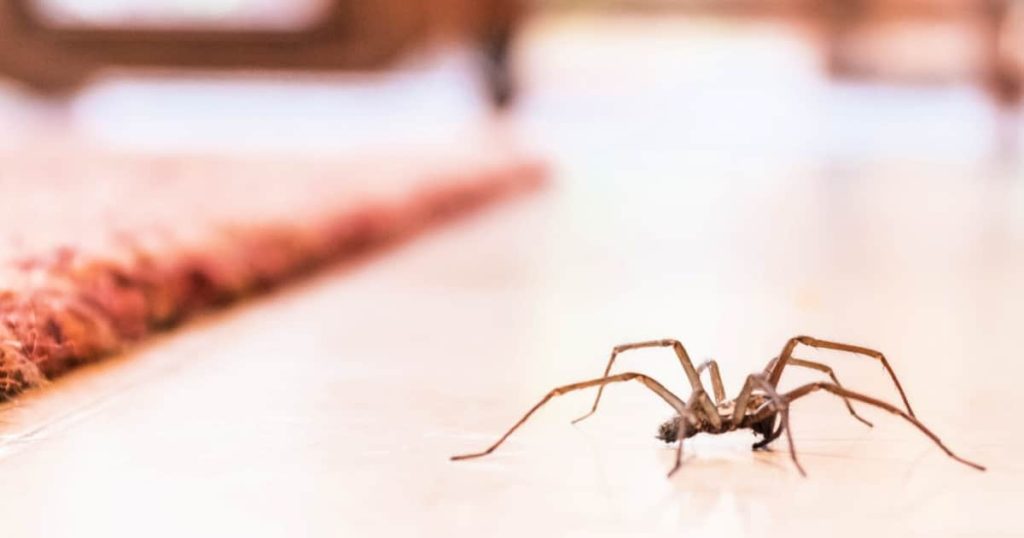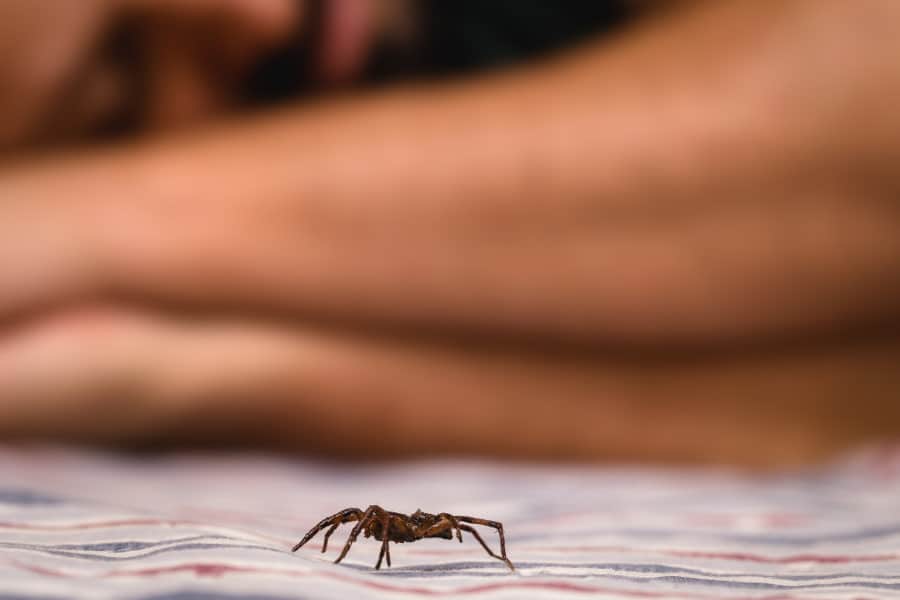The most direct way to get a spider out of hiding is to gently use a jar or container to coax it out of its hiding place and then release it outside.
The topic of safely relocating spiders is increasingly essential in today’s world as human interactions with these arachnids become more frequent.
Spiders are a common part of our natural environment, often found in our homes, gardens, and workplaces.
Their relevance lies in the essential role they play in maintaining ecological balance by controlling insect populations, which can help reduce the need for chemical pest control methods.
However, the fear and misunderstanding associated with spiders often lead to their unnecessary harm or destruction.
Safely relocating spiders not only helps preserve their role in ecosystems but also promotes a humane and environmentally responsible approach to pest control.
Identify the Spider’s Hiding Place

Tips on locating where the spider is hiding:
Observe Web Activity: One of the most effective ways to locate a spider is by observing its web. Spiders often build intricate webs to catch prey, and the web’s location can give you a clue about the spider’s whereabouts.
Nighttime Search: Many spiders are nocturnal, so consider searching for them during the evening or at night when they are more active.
Use a Flashlight: A flashlight can help you spot the spider’s eyeshine, which is a reflective glow from their eyes in low light. This is especially useful for finding spiders in dark corners or crevices.
Check Common Hiding Spots: Spiders tend to hide in specific areas. Inspect potential hiding spots, such as corners, cracks, crevices, under furniture, behind curtains, and in basements or attics.
Look for Webs: Keep an eye out for spider webs, which can often lead you to the spider’s location. These webs may be in doorways, windows, or ceiling corners.
Common hiding spots for spiders:
Corners: Spiders commonly build their webs in corners, both high and low, where walls meet ceilings or floors.
Ceilings: Check the ceiling for webs, as spiders often build their homes in out-of-reach areas.
Under Furniture: Spiders may take refuge under sofas, tables, and other pieces of furniture.
Window Sills: Spiders often build webs near windows to catch flying insects attracted to light.
Basements and Crawl Spaces: These dark and damp areas are favorite hiding spots for many spider species.
Attics: Attics can also be home to various spider species, especially if there are openings for insects to enter.
Closets and Wardrobes: Check inside closets and wardrobes, as spiders can hide in clothing or corners.
Garages and Sheds: Spiders often reside in these outdoor structures, where they can find insects and shelter.
Identifying the spider’s hiding place is the first step in safely relocating it without harm. Once you’ve located the spider, you can proceed with the relocation process, as outlined in the following sections.
Wait for the Right Time
Discuss the spider’s activity patterns, emphasizing nighttime:
Understanding the spider’s activity patterns is essential when planning its safe relocation. Many spider species are nocturnal, meaning they are most active during the night.
Nocturnal spiders have evolved to hunt and build their webs under the cover of darkness, which is when their prey is most active. This behavior is important to consider because it can affect the success of your relocation efforts.
Spiders that are active at night may retreat to their hiding spots during the day, making it challenging to locate and safely relocate them during daylight hours.
Therefore, it is often more effective to wait until evening to carry out the relocation, as the spider is more likely to be active and easier to find.
Importance of patience in the process:
Patience is a key element of safely relocating spiders. Rushing the process can lead to stress for both the spider and the person attempting the relocation, potentially resulting in harm to the spider or unintended consequences.
Minimize Stress: Spiders are sensitive creatures, and sudden movements or disturbances can cause them stress. Patiently observing and waiting for the right time minimizes stress during the relocation process.
Enhance Success: Being patient increases the likelihood of a successful relocation. Spiders are more likely to cooperate when they are active and alert, making it easier to guide them into a container for transport.
Avoid Harm: Patience ensures that you can relocate the spider without causing harm or resorting to more drastic measures that might be harmful to the spider.
In summary, waiting for the right time, which often means evening for nocturnal spiders, and exercising patience in the process is critical for a successful and humane spider relocation.
This approach prioritizes the well-being of both the spider and the person facilitating the relocation.
Encourage the Spider to Come Out
Providing light to make the spider more visible:
Spiders often hide in dark or concealed locations, and providing light can make them more visible and encourage them to emerge. To do this:
Use a Flashlight: Shine a gentle, non-intrusive light near the spider’s hiding spot. Avoid using a bright or direct light, as it can startle the spider.
Use a Red or Amber Light: Spiders are less sensitive to red or amber light, which can be a less disruptive way to make them visible without causing stress.
Creating vibrations to prompt the spider to investigate:
Spiders can be sensitive to vibrations, and creating subtle movements or vibrations near their hiding spot can pique their curiosity and prompt them to investigate. Here’s how to go about it:
Tap the Surrounding Area: Tap lightly on surfaces around the spider’s hiding spot, such as the wall or floor. This can mimic the vibrations created by potential prey and might entice the spider to emerge.
Use a Soft Brush: You can gently brush the area near the spider’s hiding place with a soft bristle brush. The vibrations from the brushing may encourage the spider to come out.
Using a gentle tapping method near its hiding spot:
Tapping is a non-invasive method to encourage the spider to leave its hiding place without causing harm. Here’s how to do it:
Tapping Technique: Gently tap the surface near the spider’s hiding spot using a soft object, such as a piece of cardboard or a feather. The aim is to create a subtle disturbance that prompts the spider to move.
Be Patient: It’s important to be patient during this process. Spiders may take some time to respond, so avoid excessive tapping or sudden, loud noises, as these can stress the spider and make it retreat further into its hiding place.
Use a Jar or Container
Steps for coaxing the spider into a container:
- Prepare the Container: Select a suitable container, such as a clean and dry glass jar. Nevertheless, you can also choose a plastic container with a secure lid to ensure the spider’s safety.
- Approach Slowly: Approach the spider with care, holding the container, and refrain from sudden movements or loud noises that could startle the spider.
- Guide with Care: Gently place the open end of the container in front of the spider without touching it. Use slow and deliberate movements to avoid frightening the spider.
- Encourage Entry: To coax the spider into the container, you can use a soft object like a piece of paper or cardboard. Gently nudge the spider’s legs or body to guide it toward the container’s opening.
- Patience is Key: Be patient during this process. Spiders may take some time to enter the container, and rushing can lead to a failed relocation or harm to the spider.
- Seal the Container: Once the spider has entered the container, carefully place the lid on the container to secure it. Make sure the lid has ventilation holes to ensure the spider can breathe.
Techniques to guide the spider without harm:
- Avoid Touching: Try to guide the spider without physically touching it, as this can stress the spider and potentially harm it. Use a soft object or implement to direct the spider gently.
- Gentle Pressure: If necessary, you can apply very gentle pressure to the spider’s abdomen or the area behind the cephalothorax (where the legs attach) to encourage it to move in the desired direction. Use minimal force to avoid injury.
- Observe and Adjust: Pay close attention to the spider’s behavior and adjust your guidance accordingly. If the spider seems agitated or reluctant to cooperate, give it a moment to calm down before proceeding.
Safety considerations when handling the spider:
- Wear Gloves: If you have concerns about potential spider bites or if the spider is of a venomous species, it’s a good idea to wear gloves to protect your hands during the relocation process.
- Identify the Spider: Before handling, try to identify the spider to the best of your ability. While many spiders are harmless to humans, it’s important to remember that some can be venomous.
- If you’re uncertain about the spider’s type, it’s advisable to exercise caution and handle the spider as if it could be potentially harmful.
- Maintain a Calm Demeanor: Remaining calm and composed during the relocation process is important. Sudden movements or panic can startle the spider, making it more difficult to guide it safely into the container.
- Release Safely: After successfully relocating the spider, take it outside and gently release it in a suitable habitat away from human living areas. Ensure the spider is not harmed during the release.
Using a jar or container is an effective and humane way to safely relocate spiders without causing them harm safely.
Release the Spider

Taking the spider outside:
Select a Suitable Location: Choose an appropriate outdoor area for releasing the spider. Ideally, this should be a natural habitat for the spider, such as a garden, forested area, or a place with vegetation where it can find shelter.
Keep the Container Secure: While transporting the spider outdoors, make sure the container’s lid is securely fastened to prevent the spider from escaping prematurely.
Handle with Care: Be gentle when carrying the container. Sudden jolts or drops can harm the spider.
The proper way to release it in an outdoor area:
Find a Suitable Spot: Once you’re in the chosen outdoor location, look for a sheltered area with vegetation, like under a bush or near a tree. This will provide the spider with cover and protection.
Open the Container: Carefully open the container in the selected spot. If the spider does not immediately exit, you can gently tilt the container to encourage it to crawl out.
Be Patient: Spiders may need a moment to acclimate to their new surroundings. Give the spider time to crawl out of the container and into its new habitat.
Avoid Handling: Resist the urge to touch or handle the spider during the release. The goal is to minimize stress and ensure a safe transition.
Observe from Afar: After releasing the spider, step back and watch from a distance if you’d like to ensure it safely enters its new environment. Do not disturb the spider during this crucial adjustment period.
Dispose of the Container: After the spider has left the container, remove it from the area and clean it thoroughly to prepare it for potential future use.
Releasing the spider in an appropriate outdoor location is the final step in a safe and humane relocation process.
FAQs
How can I safely coax a hidden spider out?
You can use a long stick or piece of cardboard to nudge the area where the spider is hiding gently.
Are there any scents or substances that can attract a spider out of hiding?
Spiders are not typically attracted to scents or substances, but you can try using a flashlight to illuminate the area to encourage it to move.
Will loud noises or vibrations make a spider come out?
Loud noises and vibrations can startle a spider, but it’s not a reliable method to make them come out of hiding.
Can I use food or bait to lure a spider out?
Spiders don’t respond to food or bait in the same way insects do, so this is not an effective strategy.
Is it safe to use a vacuum cleaner to remove a hidden spider?
Using a vacuum cleaner is an option, but it’s best to use an attachment with a long hose to avoid harming the spider.
What if the spider is in a hard-to-reach or delicate location?
If the spider is in a difficult location, it’s best to contact a pest control professional for help.
Should I wear gloves when trying to get a spider out of hiding?
Wearing gloves is an excellent idea to protect your hands, especially if you’re using a physical method to coax the spider out.
Can I use a spider-repellent spray to make it come out?
Spider-repellent sprays are more effective for preventing spiders from entering an area, not for coaxing them out of hiding.
How long should I wait before giving up on trying to get the spider out?
It’s best to be patient and give the spider some time. If it doesn’t come out on its own, consider seeking professional assistance.
Is there a humane way to encourage a spider to leave my home?
Yes, once the spider is out of hiding, you can use a container to catch and release it outside to ensure its safety gently.
Conclusion
In conclusion, safely relocating spiders without harm is not only a responsible and humane approach but also a means of promoting a harmonious coexistence between humans and these valuable arachnids.
To achieve a successful and ethical spider relocation, one must begin by identifying the spider’s hiding place, understanding its activity patterns, and exercising patience.
Using a jar or container is a safe and effective means of transporting the spider, with careful consideration for the spider’s well-being and personal safety.
This process, when conducted with care and empathy, allows for a smooth and harm-free relocation.
Finally, releasing the spider in an outdoor area that mirrors its natural habitat completes the process, ensuring that the spider can resume its essential role in the ecosystem without disruption.











